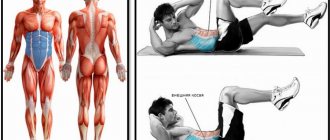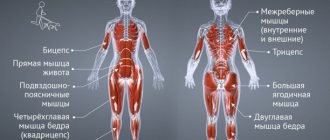It is generally accepted that for effective muscle growth it is important not only to load, but also to properly restore the body, because muscle growth occurs precisely during rest. Yes, indeed, most often the training scheme looks like this: after the training day, a recovery phase begins, and its duration can reach several days. However, despite this theory, which most athletes adhere to, there are other training regimens that will allow you to train frequently. Let's take a closer look at whether it is possible and what will happen if you train every day.
Is it possible to train every day?
Most teams in American football, soccer, hockey and other team sports adhere to five or even six-day training regimens. Here's a great example of a five-day training week for an American football team:
- Monday – training on the field (game).
- Tuesday – strength training in the gym.
- Wednesday – training on the field (impact practice, full contact).
- Thursday - rest.
- Friday – training on the field (game).
- Saturday – training on the field (punching practice, full contact).
- Sunday is rest.
Of course, such a pace cannot be constant and such a training scheme is chosen exclusively for players who have reached a high level and exclusively during the period of preparation for competitions. In the off-season, such loads lead to nothing.
By the way, in bodybuilding, you can also train often – 5-6 times a week. This kind of training is used by professional athletes or those who have stopped growing and need to increase the load on each muscle group, but at the same time not overload the body with long, grueling and debilitating workouts. In bodybuilding, this scheme is called training for one muscle group.
As you can see, even professional athletes do not perform strength training every day; in order to achieve good results, they need to rest for 1-2 days. Only high-quality recovery ensures the athlete’s growth above himself.
However, this method is not suitable for everyone. First of all, this scheme allows you to heavily load a specific muscle group. For example, the pectoral muscles, which is absolutely of no use to beginners, since at the beginning of the training journey, intense training will lead to severe soreness, overtraining and exhaustion.
If, with a normal training regimen, say, three to four workouts per week, two muscle groups can be combined in one day. For example, the antagonist muscles are the pectoral and back muscles; after such a workout you need to take a break of several days, and there will be no more than four exercises for each muscle group. But a workout designed for one muscle group can consist of six or even eight exercises. As an example, let's take back muscle training , which will consist of exercises such as:
- Wide grip pull-ups on the bar.
- Pull-ups on the bar with a reverse grip.
- Pull the block behind the head with a wide grip.
- T-bar row (or on a machine) with a horizontal grip.
- Horizontal rows to the waist in a block machine.
- Hyperextension.
Read more about all types of pull-ups →
How much to exercise for weight loss
How many kilometers should you walk a day to lose weight?
Trainers know how to lose weight through sports. To do this, you need to competently approach the organization of training. It is important to give the body time to recover. For each person, recovery follows an individual plan. The general advice from doctors is to rest for at least 24 hours after sports.
Intense training not only removes excess water, but also injures muscle tissue. The muscle fibers are stretched and torn a little. During rest, the muscles return to normal and their growth is detected. At this time, the body works to break down fat deposits. The fat layer melts, muscle tissue heals and gains volume. Because of this, weight gains slightly after sports activities in the first 7-10 days. But after two weeks of training, the mass will begin to decrease. Therefore, in order to lose weight, you cannot quit what you started. It is important to systematically perform the exercises for at least 1-2 months. By this time, you can achieve certain successes.
After training, the body needs to rest
Experts advise beginners who love physical education to exercise 3 times a week. At the same time, it is important to monitor your well-being. The first thing trainers pay attention to is a person’s pulse. Its maximum permissible value during classes is determined by the formula: 220 minus the respondent’s body weight.
Working out every day: pros and cons
Training every day is a good option for those who have stopped making progress. Typically, athletes who have reached a certain level follow this regimen. Many professional bodybuilders adhere to this scheme, but not all the time, but only in the pre-competition season. In other periods, enough time is devoted to recovery and, at a certain point, even light training. Professional athletes of team sports also divide the training process throughout the week, since it is not possible to fully train three to four times a week.
Important points to remember
Arnie, one of the most outstanding bodybuilders in the world, never missed an opportunity to train, and devoted absolutely every free minute to training. Of course, to reach such a high level, he went through quite a long journey, which allowed him to train up to several times a day. It is certainly possible to follow in the footsteps of the famous bodybuilder, but do not forget that Arnie did not immediately become strong.
As a newbie, he went to the gym no more than two or three times a week. Once his body got used to the stress, he increased the number of training days. Any other experienced athlete can do the same, but only when the muscles do not ache or ache. In addition, one should take into account the fact that victories in competitions, fame and money became an excellent incentive for him to maintain his shape.
In the world of professional bodybuilding, competition is quite fierce and every athlete strives to become better. This was the main reason that Arnie had to completely revise his training plan, increasing the intensity and frequency of training. Some bodybuilders take steroids with proteins, which allow them to speed up recovery processes and also quickly adapt to increasing loads.
The key to the success of successful bodybuilders is that they are completely able to concentrate on the training process and not be distracted. They can push themselves to the point of exhaustion even when lifting light weights because they have a clear idea of the result they want to achieve.
Another important point that absolutely all beginners should take into account is that without rest days they train inconsistently, but only three or four weeks before the competition.
What happens if you train every day?
Daily training makes it impossible for those athletes who do not use hormonal anabolic drugs and whose level of training is not high enough to fully recover. You need to approach such training gradually, trying other schemes of the training process. If you train one muscle group per day, then each muscle will have time to recover before the next week. But if you perform circular training every day, then practically none of the muscles will have time to rest, which means that you should not expect any benefit, progress, or results. Such activities will only lead to overtraining, fatigue and even irritability.
Training plan
If you are going to become the owner of a beautiful, sculpted body, you need to have a clear training plan and follow this program.
Pumping a specific muscle group every seven days
It might look like this:
- Monday - chest;
- Tuesday - back;
- Wednesday - rest;
- Thursday - legs;
- Friday - shoulders.
They rest on Saturday and Sunday. Thus, it turns out that only one large muscle is worked during the week, and then it is restored over the next week. The main thing is that specific muscles are loaded on each day.
The load on the muscle should be maximum. Otherwise, the training day will be wasted, and this will slow down the development of pumping. You can't strain yourself too much. It is necessary to maintain a good balance in order to be fully restored and full of energy before the next lesson.
Torso pumping
Carried out three times a week - Monday, Wednesday, Friday. The entire torso is loaded. The remaining days are devoted to rest. This training scheme creates a good load, but no stress. With a three-time training scheme for the entire torso, you should do from 3 to 4 sets for each muscle group within one session. In other words, the total number of approaches is 9-12.
Two-day training plan per week
On Monday and Thursday the upper torso is pumped, and on Tuesday and Friday the lower torso is pumped. Wednesday, Saturday, Sunday are days off.
It turns out that each muscle group has a separate training day. This is an intermediate option between the first and second training schemes, which allows you to avoid both excessive and low loads.
The number of approaches for each category of exercise varies from 5 to 6. The pace is chosen moderate, which allows you to maintain frequency and volume without any extremes. The total number of sets per week is 10-12.
Is it possible to train every day? 5 DETERMINING FACTORS!
How to properly train different muscle groups every day
As already mentioned, this scheme is only suitable for experienced athletes . In order to reduce the negative effects after the training process, the training week should be structured in such a way that the interval between training the same muscle group, for example legs, is as long as possible and the muscles have time to recover. Even with a four-day regimen, there is a very clear lack of recovery time if you do not correctly distribute muscle groups throughout the week.
For example, if today an athlete trained his back, then in the coming days, training that involves the biceps, a synergist of the back, will not be effective. That is, for several days after training your back muscles, you should not train your shoulders or biceps. Let's take a six-day workout as an example:
- Monday – chest muscle training.
- Tuesday – deltoid muscle training.
- Wednesday – leg workout.
- Thursday – back muscle training.
- Friday is a day of rest.
- Saturday – arm workout (biceps, triceps and forearm).
- Sunday – leg workout.
Restoring the body between workouts
To answer this question, it is necessary to understand the process of recovery of the body after training. To do this, it is necessary to eliminate all microdamage to tissues, replenish energy sources, and carry out a supercompensation phase. Recovery time is influenced by a large number of factors. These include the intensity of the activity, the body’s susceptibility to stress, working weights, etc.
It is now believed that recovery requires at least a day. This is the minimum period of time during which the body can prepare for new stress. This applies more to beginners who have been training for less than three months, older people and athletes who do not use high-intensity training.
There is also a maximum recovery period of three days. This is how much an athlete will need after intense training with heavy weights. However, you should not accept all these numbers as the only true ones.
How often should you work on each muscle group in the gym?
It is now a very common belief that each large muscle group should be trained once during the week, and you can even work on the same abs every day. But at the same time, they do not remember that each person’s recovery capabilities are different, and you must find out them and only then make a decision. There are several principles that you need to consider when creating a training program.
Large groups should rest longer
The more massive the muscle, the more time the body will need to recover.
This is primarily due to the fact that they need to be trained more intensively. The large muscle groups include the back, legs and chest, while the calves and arms are small groups. Many split programs combine training of a large group and a small one; for example, the legs can be trained together with the shoulder girdle. This is not entirely good, since the leg muscles are almost half of the entire body muscles. The best option is to allocate a separate day of exercise for the legs. You must understand that your legs will take significantly longer to recover compared to your arms or shoulder girdle.
Beginners may need less rest
Beginners simply cannot work at high intensity. By the way, the word “beginners” should be understood as athletes whose training experience does not exceed one year. Since the intensity of their training is less than that of experienced bodybuilders, they do not cause as much damage to tissues. After training large muscles, they often only need a maximum of two days to recover.
Experienced athletes need more rest
Since they train intensely, they need to rest more. Compared to beginners, after their training, the muscles receive more serious damage, which takes a long time to recover. They need to rest for two to three days.
Number of approaches and duration of classes
You must remember that your muscles must work for 40 or 45 minutes. This is pure training time, which is primarily affected by the number of approaches and repetitions. There is a rule you should know:
- Large muscles - 4-6 approaches.
- Small muscles - 1-3 approaches.
We have already said above that many are confident in the need for frequent training of the abdominal muscles. It is not clear why such a decision was made, because the abs are an ordinary muscle and the same principles apply to it as to other groups. To properly work out your abs, you only need to train them a couple of times during the week. The same can be said about the number of repetitions. Sometimes you can find information about the need to perform 100 repetitions at once. Don't listen to anyone and do 20 to 25 reps. This will be more than enough.
Is light exercise every day beneficial?
If you consider daily training as exercise, a light jog or several exercises with your own weight, then such an activity will not harm anyone. Unfortunately, a person will not receive results from such training. But, as you know, movement is life, so such morning exercises will give a person vigor, good mood and well-being. The main thing is not to overwork and feel the line between a light load for your health and an intensive one.
Lightweight training is a set of pull-ups, push-ups, crunches and squats that can be done at home, and it is best to alternate them with short morning jogs. All these exercises should not be performed daily; it is better to distribute them every other day and alternate with jogging.
Training frequency with an emphasis on muscle growth
The unique thing about training with an emphasis on muscle growth is that when we strive to increase strength, mass certainly increases. That is why, training to increase strength indicators also increases muscle mass .
Frequency of training to increase muscle mass
Depending on your level of training (beginner, experienced or advanced), you need to choose the optimal frequency of the training process for muscle growth.
- Beginner (no more than 3 workouts per week are recommended; more frequent workouts can lead to overtraining)
- Experienced (about 3-4)
- Advanced (5 workouts are possible, the main thing is that the load is correctly distributed among muscle groups)
Let's find out what the science says about training frequency when focusing on muscle growth.
Experiment: how training frequency affects an athlete’s strength and muscle mass levels
In 2018, a scientific experiment was conducted, the essence of which was that scientists took a group of 23 test athletes , which were randomly divided into 2 subgroups . The first did few exercises (according to the split principle), the second the same amount of training load .
- Group 1 performed 2 exercises in 5-10 working approaches
- Group 2 performed 11 exercises , but performed only 1-2 working approaches in each of them
Both subgroups trained 5 days a week (Monday to Friday).
1st (left) and 2nd (right) experimental group and their exercises
The study lasted 8 weeks , and the final assessment was that both groups gained in both strength and muscle hypertrophy (see graph), but the group that trained frequently managed to outperform slightly more in the long term. this gap would only increase.
The study itself is called:
High-frequency resistance training is not more effective than low-frequency resistance training in increasing muscle mass and strength in well-trained men. Gomes GK, Franco CM, Nunes PRP, Orsatti FL. J Strength Cond Res. 2020 Feb 27. doi: 10.1519/JSC.0000000000002559.
It is also worth noting that athletes from the first group , where training of individual muscle groups was carried out rarely, complained more about post-workout muscle soreness ( soreness ), although their results turned out to be worse (that is, muscle pain is not always good and better than then, when she's not there).
Experiment results
Another scientific study (Tang, JE, Perco, JG, Moore, DR, Wilkinson, SB, & Phillips, SM (2008). Resistance training alters the response of a fed state mixed muscle protein synthesis in young men. American Journal of Physiology- Regulatory, Integrative and Comparative Physiology, 294(1), R172-R178.) based on the results of which scientists found that in a beginner athlete, the muscles respond much better to the load and continue to grow for another 2-3 days , while in an experienced this period is about 16 hours .
Naturally, you must understand that all these scientific experiments are only recommended , and not as instructions for action.
8 weeks is not one or 2 years, and all these experiments do not take into account many factors , for example, how a person eats, how he recovers outside of training, how hard he works (after all, in fact, there are many hacks). Therefore, the most correct indicator in everything in this matter is your well-being and naturally positive dynamics in achieving your goal.
In addition, it cannot be said that some basic exercises (for example, deadlifts or squats with a barbell on the shoulders) involve many muscle groups, and a load of 70-80% , provided that the person does not slack, can cause significant fatigue and There can be no talk of any daily training.
Is it possible for a girl to train to lose weight every day?
Even for the purpose of losing weight, daily training is not the best option.
- Firstly, for a fat-burning effect, you need to keep your heart rate in the range of 50-70% of the maximum. Learn more about heart rate zones →
- Secondly, the average duration of one workout should be 40 minutes.
Therefore, the load on the cardiovascular system will be noticeable, which naturally implies at least a day of rest between workouts.
Frequency of training when losing weight (burning fat)
The frequency of training when losing weight can be different, and everything will depend directly on the goal : some athletes need to dry out muscle mass, that is, lose weight and at the same time keep their muscles in good shape , while other athletes (especially females) are concerned exclusively with a slim figure.
When drying muscles
Athletes who want to lose weight for the purpose of drying muscles should proceed from real capabilities to visit the gym/gym; the frequency of training will depend on this.
For example, from this article, you may know that the best way to dry muscles is to separate cardio training from strength ; in this case, the frequency of the training process can reach 5-6 workouts per week. But if you don’t have the opportunity to go to the gym, then do 3 full strength training sessions with cardio in one day , with aerobic exercises coming after you have already completed your strength training program. Otherwise, you simply won’t have the strength (due to glycogen ) to perform strength exercises , but fullness and muscle tone should be a priority .
Frequency of muscle cutting training
For normal weight loss (for a slim figure)
Regular weight loss or weight loss differs from drying mainly in that the athlete does not strive for relief of muscle mass, that is, the main goal is to get rid of excess fat , make a slim figure, everything else goes by the wayside. Therefore, in this case, it will be easier for you to lose weight correctly.
The frequency of training should range from 3-5 times a week , depending on your level of fitness (the higher it is, the more you can train). And of course, you need to take into account the duration of the training session; the shorter it is, the more training sessions there should be per week.
The intensity of training for the purpose of losing weight should be moderate and keep your heart rate at 120-130 beats per minute (active fat burning zone).
Frequency of training when losing weight
How many hours a week should you train?
The World Health Organization (WHO) recommends Physical Activity and Adults that adults include at least 75 minutes of vigorous exercise or 150 minutes of gentler activity per week. Here are some examples of suitable activities: What is Moderate-intensity and Vigorous-intensity Physical Activity? .
- Work with moderate intensity (with a pulse of Methodological recommendations. Providing physical activity for citizens with health limitations of 90–110 beats per minute): fast walking, dancing, working in the garden and around the house, picking mushrooms and berries, active games with children and pets, repairs, carrying things less than 20 kg.
- High-intensity activities (heart rate above 120 bpm): running, walking up hills, fast cycling, aerobics, fast swimming, competitive sports and team games (soccer, volleyball, basketball, etc.), digging, carrying things heavier than 20 kg.
However, WHO notes that this is the required minimum. To reap additional health benefits, exercise more: 300 minutes at moderate intensity and 150 minutes at high intensity. About the same amount is needed The effect of lifelong exercise frequency on arterial stiffness to maintain the elasticity of the large central arteries until old age.
Scientists tested Leisure time physical activity and mortality: a detailed pooled analysis of the dose-response relationship, how physical activity affects mortality from any cause, and found a clear pattern: 75 minutes of exercise per week reduces the overall risk of death by 20%, 150 minutes - by 31%, and 150–255 minutes - by 37%. But the biggest benefits come from 225-375 minutes (3 hours 45 minutes - 6 hours 25 minutes) per week. With such loads, the risk of death is reduced by a record 39%.
To get the most benefits, exercise 2.5 to 6.5 hours per week. The bigger, the better.











